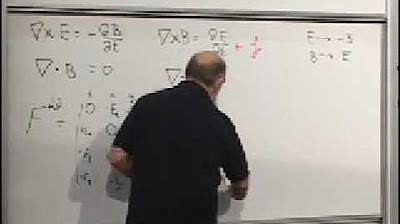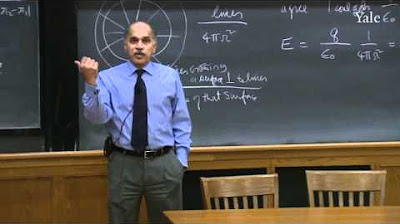The Electromagnetic field, how Electric and Magnetic forces arise
TLDRThe video script explores the concept of the electromagnetic field, delving into the interactions between charged particles at a quantum level. It explains how virtual photons mediate the repulsive force between electrons, leading to an understanding of electric charge. The script further discusses the electric field as an invisible fabric influenced by charges, and how it can be visualized around particles. The magnetic force is introduced as a peculiar phenomenon that affects moving charges, explained through the lens of special relativity. The script culminates in Maxwell's equations, highlighting the interplay between electric and magnetic fields and their propagation as electromagnetic waves. The content is engaging, blending theoretical physics with relatable examples to demonstrate the principles of electromagnetism.
Takeaways
- 🌌 The concept of action and reaction is demonstrated by two people playing catch in space, where each person experiences a recoil due to the exchange of momentum.
- 🤹♂️ Quantum scale interactions, such as electrons exchanging virtual photons, result in repulsive forces similar to the ball game in space.
- 💡 Virtual photons are short-lived particles with varying energy and range, depending on their energy levels.
- 🔋 The electric charge is responsible for the interactions between particles, with like charges repelling and opposite charges attracting.
- 🌀 The electric field is an imaginary construct that represents the influence of charged particles and can be visualized as colored areas affecting particles differently based on their charge.
- 🔧 The magnetic force is a peculiar force that acts on moving charged particles and is related to the motion and speed of the particle, as well as the direction of the field.
- 🌐 Special relativity plays a role in the behavior of the magnetic force, as the moving object's frame of reference affects the perception of electric and magnetic fields.
- 🔄 The magnetic field is the result of a moving electric charge and is represented by circular arrows around the direction of motion.
- 📜 Maxwell's equations are the fundamental principles that govern the behavior and interaction of electric and magnetic fields.
- 🌬️ Electromagnetic waves, including light and radio waves, are a manifestation of the oscillation between electric and magnetic fields and travel at the speed of light.
- 🚀 Electromagnetic principles are applied in various technologies, such as generators in wind turbines and nuclear power plants, which use the principles of induction to convert motion into electric signals.
Q & A
What happens when two people play catch in the void of space?
-When two people play catch in the void of space, they experience a recoil as they pass momentum onto the ball. This causes them to repel each other and move from a state of rest to motion, increasing their speeds with each pass.
How does the exchange of virtual photons between electrons manifest as a force?
-The exchange of virtual photons between electrons results in a repulsive force that pushes them away from each other. This force becomes stronger as the distance between the electrons shortens, as the virtual photons have less distance to travel and can be more energetic.
What is the basic unit for electric charge?
-The basic unit for electric charge is 'e', and particles can have a multiple of this elementary charge.
How do particles with the same charge interact?
-Particles with the same charge repel each other. For example, two electrons with a charge of -1e will repel each other, while two protons with a charge of +1e will also repel each other.
How do particles with opposite charges interact?
-Particles with opposite charges attract each other. For instance, a negatively charged electron and a positively charged proton will be attracted to one another.
What is an electric field and how can it be visualized?
-An electric field is a conceptual field that represents the force that would be exerted on a charged particle placed within it. It can be visualized as an imaginary fabric that changes color based on the charge placed in it. Positive charges turn the field red, while negative charges turn it blue.
How does an electric current create an electric field?
-An electric current, consisting of moving electrons, creates an electric field as the electrons move along the wire. This field can be uniform, like in a wire with a consistent charge distribution, or it can vary depending on the arrangement of charges.
What is the magnetic force and how does it relate to the electric force?
-The magnetic force is a force that acts on a moving charged particle and is a consequence of special relativity. It is essentially an electric force perceived from a different reference frame, where the charged particle is moving relative to the observer.
How do the electric and magnetic fields evolve with respect to each other according to Maxwell's equations?
-Maxwell's equations describe how electric and magnetic fields evolve with respect to each other. One equation states that a disturbance in the magnetic field affects the electric field, leading to electromagnetic induction. Another equation states that an electric current or change in the electric field disturbs the magnetic field, allowing for the propagation of electromagnetic waves.
What are the four fundamental principles of the electromagnetic field?
-The four fundamental principles of the electromagnetic field, known as Maxwell's equations, are: 1) an electric charge is the source of an electric field, 2) standalone magnetic charges cannot exist, 3) a disturbance in the magnetic field can induce an electric field, and 4) an electric current or change in the electric field can disturb the magnetic field.
How can electromagnetic waves be generated and what types of waves are included?
-Electromagnetic waves can be generated through the interaction and disturbance of electric and magnetic fields. These waves include microwaves, X-rays, infrared, and visible light.
What is the role of special relativity in understanding the magnetic force?
-Special relativity plays a crucial role in understanding the magnetic force. It explains that the electric field of a moving charge gets distorted, leading to the appearance of the magnetic force. This is observed from a reference frame where the charge appears to be moving, such as when considering the frame of the apple in the script.
Outlines
🌐 Introduction to Electromagnetic Fields
This paragraph introduces the concept of electromagnetic fields through an analogy of two people playing catch in space. It explains how the exchange of momentum between them leads to a repulsive force, similar to how electrons repel each other by exchanging virtual photons. The phenomenon of particles with electric charge is discussed, highlighting that like charges repel and unlike charges attract. The electric field is introduced as an imaginary fabric that represents the influence of charged particles on their surroundings, with examples of how it behaves around different charges.
💡 The Mysterious Magnetic Force
This paragraph delves into the concept of the magnetic force, which becomes apparent when a charged object moves. It describes an experiment with an apple near a wire carrying a current, illustrating how the apple is repelled by the wire when it moves. The explanation involves the effects of special relativity and the contraction of lengths at high speeds. The magnetic force is shown to be a consequence of the electric force as perceived from a moving reference frame, and the concept of magnetic fields is introduced, with examples of electromagnets and permanent magnets.
📐 Maxwell's Equations and Electromagnetic Waves
The final paragraph discusses the unification of electric and magnetic fields under the concept of the electromagnetic field and introduces Maxwell's equations. It explains the four fundamental principles that govern the behavior and interaction of electric and magnetic fields, including the sources of electric fields, the non-existence of standalone magnetic charges, and the mutual influence of electric and magnetic fields leading to electromagnetic waves. The paragraph also describes how changes in these fields can induce currents, as in the case of generators and transformers, and concludes with an example of how electromagnetic fields can slow down the motion of a falling magnet, effectively reducing its acceleration due to gravity.
Mindmap
Keywords
💡Electromagnetic field
💡Virtual photons
💡Electric charge
💡Magnetic force
💡Special relativity
💡Electromagnetism
💡Maxwell's equations
💡Induction
💡Electromagnetic waves
💡Spin
Highlights
Two individuals in space playing catch with a ball demonstrate the principle of recoil due to momentum transfer.
The exchange of virtual photons between electrons at the quantum scale results in a repulsive force.
Virtual photons, stemming from quantum physics, can appear and disappear as long as they do so quickly enough to avoid detection.
The electric charge is the interaction tendency of particles, such as electrons and protons, which can either repel or attract each other based on their charge signs.
The electric field is an imaginary concept that visualizes the influence of electric charges on their surroundings.
Protons and electrons in a wire can create an electric current, which in turn generates a magnetic field.
The magnetic force is a peculiar force that only acts on moving charges and depends on the charge's speed and direction.
Special relativity plays a role in the behavior of electric and magnetic fields, especially when charges are in motion.
The magnetic field is a consequence of special relativity and behaves strangely, exerting forces on moving particles based on their motion relative to the field.
An electromagnet is created by winding a wire into a coil and applying an electric current, which results in a large-scale magnetic field.
Elementary particles possess a quantum property called spin, which generates a magnetic field when aligned in a material.
The electromagnetic field is a unifying concept that encompasses both electric and magnetic fields, governed by Maxwell's equations.
Maxwell's equations describe the fundamental principles of how electric and magnetic fields interact and evolve.
Induction is the process by which a changing magnetic field can induce an electric current in a wire.
A change in the electric field can disturb the magnetic field, which in turn can affect the electric field again, allowing for the propagation of electromagnetic waves.
Electromagnetic waves, including light and radio waves, travel at the speed of virtual photons and can be generated by the alternation of electric and magnetic fields.
The phenomenon of slowing down gravity is demonstrated by dropping a magnet over a coil of wire, which shows the interplay between electric current and magnetic fields.
Transcripts
5.0 / 5 (0 votes)
Thanks for rating:





